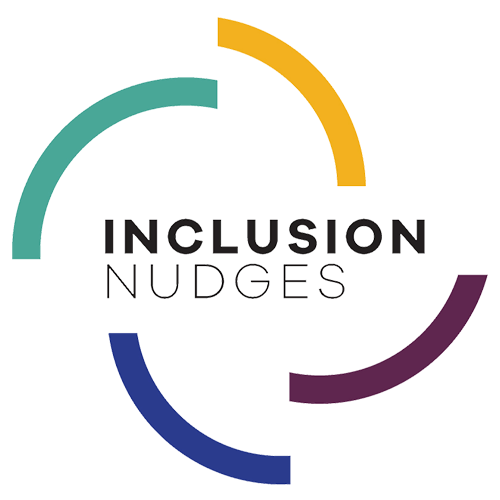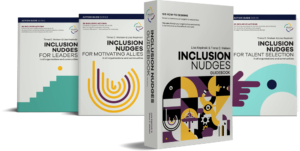During 2020 and onward, there have been urgent calls to action for creating a more inclusive and equitable world. As change makers for creating equitable systems and expanding perspectives, interactions, and decisions to be more inclusive of all people, we can be up against a seemingly ‘invisible’ force within ourselves that blocks change happening—a deep unconscious preference for the STATUS QUO. Here we give you a practical way that you can apply behavioural insights to overcome this trap (in yourself and others), avoid performative diversity, equity, & inclusion (DEI) efforts, and foster a ‘catapult’ change mindset in all people.
The ease and comfort of the familiar! Ohh, do we know it! We (Lisa and Tinna) have as change makers, let the status quo bias drive our actions, even when we know it’s not ideal and will not create the needed changes. It’s a reality that stems from a natural human need for predictability, order, and familiarity which increases when faced with what seems like chaos and uncertainty.
We have all been affected by the globally-shared pandemic experience, but not all people’s realities have been equal. Nor is the recovery ahead one that is on a fair, level platform for all. In many countries, people are voicing their discontent and demands for change. There are now, more than ever, heightened awareness and calls for substantive actions to address inequities. As change makers for diversity, equity, and inclusion (DEI), it’s an urgent time for us to lead the way with effective change actions and avoid performative steps and maintaining the harmful status quo.
But making change happen is, quite frankly, damn hard! We often say from our DEI change experiences that it’s like pushing water up a hill. While we may know on a rational level in our system 2 thinking that change is needed, it still can cause us to feel out of control, confused, and concerned. When faced with an upheaval in our ‘normal’, it’s no wonder that we feel this way. There are powerful unconscious mental drivers enmeshed with our emotions that shape how we and others react to change. And this can be a hidden barrier to the change maker.
Here are two examples of mindsets on change that we have seen having implications for DEI change initiatives.
The ‘Elastic Band’ change mindset
An elastic band has the capability to expand when needed and then contract back to its original shape. Similarly, when faced with a need to adopt new behaviours, we may stretch to do these, but there’s a powerful pull to revert back to the old ways. The familiar is comfortable and the new can evoke fear and may even feel painful. It’s no wonder that we’d want to embrace what is known already, even when it may not be ideal for ourselves and others. This is the ‘status quo bias’ taking over our reaction to change.
Yet, the experiences since 2020 have shown that we can quickly adopt and adapt to new ways of living, connecting, working, educating, governing, entertaining, and so much more. There’s very little in our lives that remained the same as a result of the pandemic. Still for many people, there is the hope for “when we return back to normal”.
The ‘Elastic Band Mindset’ to change is when we stretch to try something new if needed, but when the need lessens then we contract back to the previous ways.
So, what does this mean for DEI change makers? With the ‘Elastic Band Mindset’, changes are viewed as temporary responses to a momentary dynamic—something that will pass soon. Thus, when an inequity issue is framed as an unusual point in time, then there is no perception of a need for permanent change. Innovating for new solutions to increase equity, behave inclusively, and leverage the diversity of all people, doesn’t get to deep system issues. The short-term gets the focus until the situation changes. This can cause a rise in performative allyship rather than lasting behavioural change. This mindset frequently blocks successful DEI change results. Here are some examples:
- Momentary appearance to change: In response to #BlackLivesMatter during the summer of 2020, there were many CEOs’ statements and philanthropy donations to racial justice initiatives. While some organisations have made lasting changes beyond these first steps, there are frustratingly many more with very little shifts in racial diversity representation and policy changes. A survey by Ipsos & the World Economic Forum across 27 countries found that “an average of 65% of adults think that, in their country, someone’s race, ethnicity, or national origin influences their employment opportunities”. Inequalities still remain despite some initial steps. The response falls short and the previous status quo reverts.
- Ineffectively-directed change action: Many organisations are focused on increasing gender and under-represented diversity groups in senior levels. Typically, the ‘go-to’ solution is mentoring. But the problem with this is that it is a short-term transactional solution rather than a deep organisational systemic change addressing gender disparities, the decision-makers, and processes. The status quo supporting the inequalities stays in place and the energy is misplaced on fixing the women and people from the minority groups.
The ‘Catapult’ change mindset
Another orientation towards change is what we call the ‘Catapult Mindset’. This is when a situation, such as the pandemic, becomes the catalyst to accelerating innovation and new approaches to improve the past ways. It’s grounded in a realisation that there were aspects that were not working well previously. The year of 2020 brought to the forefront a focus on racism/skin colour bias and many other social injustices, outdated past ways of working, mental health issues, widening wealth gaps, and so much more.
A ‘Catapult Mindset’ towards change is framed with an orientation of “why would we want to go back to that past reality?”
A ‘Catapult Mindset’ focuses on creating new solutions to address past problems. It is future focused. This mindset is embedded in the World Economic Forum’s The Great Reset, the OECD’s Inclusive Recovery, The World Bank’s focus on a resilient and inclusive recovery, and The United Nation’s Building Back Better initiatives. The head of the International Monetary Fund, Kristalina Georgieva, sums up this mindset: “There is much uncertainty about the shape of our future. But we can also embrace this crisis as an opportunity—to craft a different and better future together.”
So how can DEI change makers help to get more people onboard with innovating for a more inclusive future to realise all people’s potential instead of waiting on getting back to ‘normal’?
What works to increase support, engagement, & achievement for your DEI change initiative
To achieve impactful change, we need to make people ‘Feel the Need’ to be inclusive. To have true impact, we need to help other people see and feel hidden problems and solutions in ways that influence their emotions and perceptions. Research shows that the sequence of change is ‘See-Feel-Change’ and it’s not by knowing and rationally understanding the need for change. This is particularly the case when it comes with changes for diversity, equity, and inclusion because of the stuck patterns combined with shame, blame, and blindness at the core of these issues.
When we developed the Inclusion Nudges change approach it was to enforce a catapult mindset in all of us and make it easy for all people to enable change by appealing to the behavioural drivers, biases, and emotions in the unconscious mind.
It can be hard to see the existing norms, patterns, processes, and policy implications on diversity, equity, and inclusion. By conducting data gathering and analysis, these can be revealed through ‘eye opener’ Inclusion Nudges that help people realise themselves where there are inequalities (rather than being told what are the current issues). Seeing what is the status quo and its impact, helps to motivate people to support the needed changes and even be a part of co-creating the changes (a ‘Catapult Mindset’).
CASE:
Realising ‘how we work’ requires a change!
A national film institute had a DEI goal to ensure more diversity in the films being produced. But to fully get all on-board with this change, they needed to see what were their evaluation decision patterns which didn’t support that goal. Tinna worked with them to design an eye-opener Inclusion Nudge that showed them that their mind makes a decision about which film to support within only a few seconds (in average it was 3 seconds). Another eye-opener was when they realised that the group who thought the scriptwriter, the instructor, and the producer were all men, they were more likely to support them, while it was the opposite with the group who thought it was a team of three women. After experiencing it, each of them was motivated to experiment with new ways of working and co-create change to the organisational processes and ensure structural and cultural changes by applying process design Inclusion Nudges. Three years after the start of this work, they are still working proactively on this and still experimenting with making improvements.
You can read about this Inclusion Nudge called Realise & Mitigate Biased Decisions About Quality in The Inclusion Nudges Guidebook and in the Inclusion Nudges for Motivating Allies. In the Action Guide with Inclusion Nudges for Talent Selection you get all the process design Inclusion Nudges they are applying at the film institute.
Get access to more designs to achieve your diversity, equity, & inclusion initiatives
True change towards more inclusive organisations, communities, and societies is a journey towards getting as many people as possible motivated and engaged in making the needed changes. If this is something that you are working on and you want proven ways of how to optimise the ‘Catapult Mindset’, then the Inclusion Nudges for Motivating Allies book is for you! It has 30 step-by-step examples that you can adapt to your change initiative.
Want to explore more? Check out these other Inclusion Nudges blog articles:
The Power of Inclusion Nudges
Data as a Catalyst for Designing Change
Mandate for Change
Ask Tinna & Lisa: Why Sponsor, Not Mentor
Allies by Action—Not by Posting on Social Media







